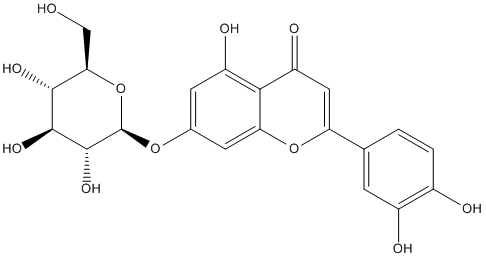Cynaroside
found in different plants (e.g. Taraxacum (Dandelion Pissenlit)). Antioxidant, interacts with many enzymes
General
Type : Glycoside,Natural,Flavonoid
Chemical_Nomenclature : 2-(3,4-dihydroxyphenyl)-5-hydroxy-7-[(2S,3R,4S,5S,6R)-3,4,5-trihydroxy-6-(hydroxymethyl)oxan-2-yl]oxychromen-4-one
Canonical SMILES : C1=CC(=C(C=C1C2=CC(=O)C3=C(C=C(C=C3O2)OC4C(C(C(C(O4)CO)O)O)O)O)O)O
InChI : InChI=1S\/C21H20O11\/c22-7-16-18(27)19(28)20(29)21(32-16)30-9-4-12(25)17-13(26)6-14(31-15(17)5-9)8-1-2-10(23)11(24)3-8\/h1-6,16,18-25,27-29H,7H2\/t16-,18-,19+,20-,21-\/m1\/s1
InChIKey : PEFNSGRTCBGNAN-QNDFHXLGSA-N
Other name(s) : Luteoloside,Luteolin 7-glucoside,Luteolin-7-O-glucoside,CHEMBL233929,CHEBI:27994,SCHEMBL149118
MW : 448.4
Formula : C21H20O11\
CAS_number : 5373-11-5
PubChem : 5280637
UniChem : PEFNSGRTCBGNAN-QNDFHXLGSA-N
IUPHAR :
Wikipedia :

Target
Families : Cynaroside ligand of proteins in family: Lipoprotein_Lipase
Stucture :
Protein : human-LIPG
References (11)
| Title : A Proof-of-Concept Inhibitor of Endothelial Lipase Suppresses Triple-Negative Breast Cancer Cells by Hijacking the Mitochondrial Function - Yang_2022_Cancers.(Basel)_14_3763 |
| Author(s) : Yang R , Han S , Clayton J , Haghighatian M , Tsai CC , Yao Y , Li P , Shen J , Zhou Q |
| Ref : Cancers (Basel) , 14 :3763 , 2022 |
| Abstract : Yang_2022_Cancers.(Basel)_14_3763 |
| ESTHER : Yang_2022_Cancers.(Basel)_14_3763 |
| PubMedSearch : Yang_2022_Cancers.(Basel)_14_3763 |
| PubMedID: 35954428 |
| Gene_locus related to this paper: human-LIPG |
| Title : Neuroprotective Effect of Luteolin-7-O-Glucoside against 6-OHDA-Induced Damage in Undifferentiated and RA-Differentiated SH-SY5Y Cells - Rehfeldt_2022_Int.J.Mol.Sci_23_ |
| Author(s) : Rehfeldt SCH , Silva J , Alves C , Pinteus S , Pedrosa R , Laufer S , Goettert MI |
| Ref : Int J Mol Sci , 23 : , 2022 |
| Abstract : Rehfeldt_2022_Int.J.Mol.Sci_23_ |
| ESTHER : Rehfeldt_2022_Int.J.Mol.Sci_23_ |
| PubMedSearch : Rehfeldt_2022_Int.J.Mol.Sci_23_ |
| PubMedID: 35328335 |
| Title : UPLC-PDA-ESI-QTOF-MS\/MS fingerprint of purified flavonoid enriched fraction of Bryophyllum pinnatum\; antioxidant properties, anticholinesterase activity and in silico studies - Ogidigo_2021_Pharm.Biol_59_444 |
| Author(s) : Ogidigo JO , Anosike CA , Joshua PE , Ibeji CU , Ekpo DE , Nwanguma BC , Nwodo OFC |
| Ref : Pharm Biol , 59 :444 , 2021 |
| Abstract : Ogidigo_2021_Pharm.Biol_59_444 |
| ESTHER : Ogidigo_2021_Pharm.Biol_59_444 |
| PubMedSearch : Ogidigo_2021_Pharm.Biol_59_444 |
| PubMedID: 33930998 |
| Title : Chemical Composition, Antioxidant and Enzyme Inhibitory Activities of Onosma bourgaei and Onosma trachytricha and in Silico Molecular Docking Analysis of Dominant Compounds - Istifli_2021_Molecules_26_2981 |
| Author(s) : Istifli ES |
| Ref : Molecules , 26 :2981 , 2021 |
| Abstract : Istifli_2021_Molecules_26_2981 |
| ESTHER : Istifli_2021_Molecules_26_2981 |
| PubMedSearch : Istifli_2021_Molecules_26_2981 |
| PubMedID: 34069766 |
| Title : Phytochemical Composition, Antioxidant, and Enzyme Inhibition Activities of Methanolic Extracts of Two Endemic Onosma Species - Saravanakumar_2021_Plants.(Basel)_10_ |
| Author(s) : Saravanakumar K , Sarikurkcu C , Sahinler SS , Sarikurkcu RB , Wang MH |
| Ref : Plants (Basel) , 10 : , 2021 |
| Abstract : Saravanakumar_2021_Plants.(Basel)_10_ |
| ESTHER : Saravanakumar_2021_Plants.(Basel)_10_ |
| PubMedSearch : Saravanakumar_2021_Plants.(Basel)_10_ |
| PubMedID: 34371578 |
| Title : In vitro enzyme inhibitory and anti-oxidant properties, cytotoxicity and chemical composition of the halophyte Malcolmia littorea (L.) R.Br. (Brassicaceae) - Castaneda-Loaiza_2020_Nat.Prod.Res__1 |
| Author(s) : Castaneda-Loaiza V , Placines C , Rodrigues MJ , Pereira CG , Zengin G , Neng NR , Nogueira JMF , Custodio L |
| Ref : Nat Prod Res , :1 , 2020 |
| Abstract : Castaneda-Loaiza_2020_Nat.Prod.Res__1 |
| ESTHER : Castaneda-Loaiza_2020_Nat.Prod.Res__1 |
| PubMedSearch : Castaneda-Loaiza_2020_Nat.Prod.Res__1 |
| PubMedID: 32013559 |
| Title : Novel in vitro and in silico insights of the multi-biological activities and chemical composition of Bidens tripartita L - Uysal_2017_Food.Chem.Toxicol_111_525 |
| Author(s) : Uysal S , Ugurlu A , Zengin G , Baloglu MC , Altunoglu YC , Mollica A , Custodio L , Neng NR , Nogueira JMF , Mahomoodally MF |
| Ref : Food & Chemical Toxicology , 111 :525 , 2017 |
| Abstract : Uysal_2017_Food.Chem.Toxicol_111_525 |
| ESTHER : Uysal_2017_Food.Chem.Toxicol_111_525 |
| PubMedSearch : Uysal_2017_Food.Chem.Toxicol_111_525 |
| PubMedID: 29217268 |
| Title : Taraxacum mongolicum extract induced endoplasmic reticulum stress associated-apoptosis in triple-negative breast cancer cells - Li_2017_J.Ethnopharmacol_206_55 |
| Author(s) : Li XH , He XR , Zhou YY , Zhao HY , Zheng WX , Jiang ST , Zhou Q , Li PP , Han SY |
| Ref : J Ethnopharmacol , 206 :55 , 2017 |
| Abstract : Li_2017_J.Ethnopharmacol_206_55 |
| ESTHER : Li_2017_J.Ethnopharmacol_206_55 |
| PubMedSearch : Li_2017_J.Ethnopharmacol_206_55 |
| PubMedID: 28461119 |
| Title : Inhibitory effect of Lavandula viridis on Fe(2+)-induced lipid peroxidation, antioxidant and anti-cholinesterase properties - Costa_2011_Food.Chem_126_1779 |
| Author(s) : Costa P , Goncalves S , Andrade PB , Valentao P , Romano A |
| Ref : Food Chem , 126 :1779 , 2011 |
| Abstract : Costa_2011_Food.Chem_126_1779 |
| ESTHER : Costa_2011_Food.Chem_126_1779 |
| PubMedSearch : Costa_2011_Food.Chem_126_1779 |
| PubMedID: 25213957 |
| Title : Effects of extract from Angelica keiskei and its component, cynaroside, on the hepatic bromobenzene-metabolizing enzyme system in rats - Park_2002_Phytother.Res_16 Suppl 1_S24 |
| Author(s) : Park JC , Park JG , Kim HJ , Hur JM , Lee JH , Sung NJ , Chung SK , Choi JW |
| Ref : Phytother Res , 16 Suppl 1 :S24 , 2002 |
| Abstract : Park_2002_Phytother.Res_16 Suppl 1_S24 |
| ESTHER : Park_2002_Phytother.Res_16 Suppl 1_S24 |
| PubMedSearch : Park_2002_Phytother.Res_16 Suppl 1_S24 |
| PubMedID: 11933135 |
| Title : Luteolin-7-glucosid-sesquihydrat. - |
| Author(s) : Nakamura H , Ohta T , Hukuti G |
| Ref : J. Pharm. Soc. Japan , 56 :107 , 1936 |
| PubMedID: |